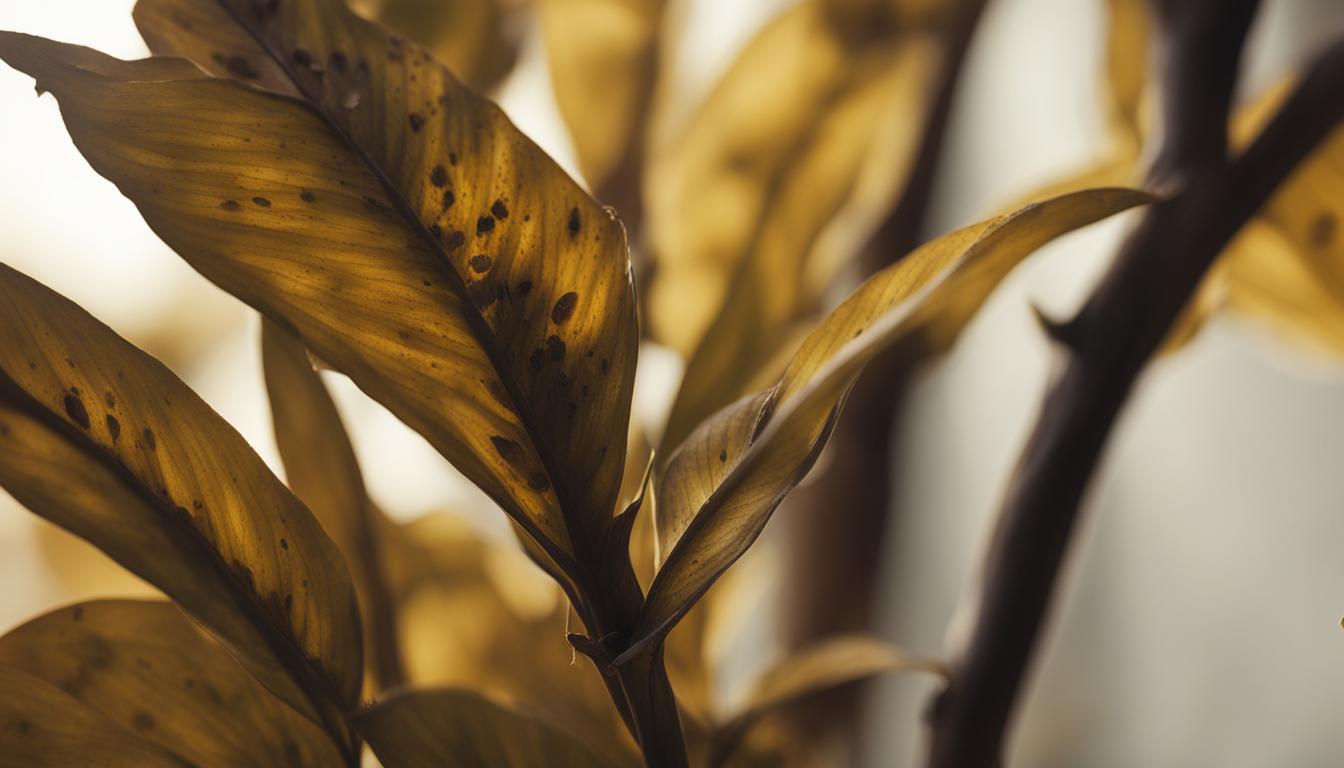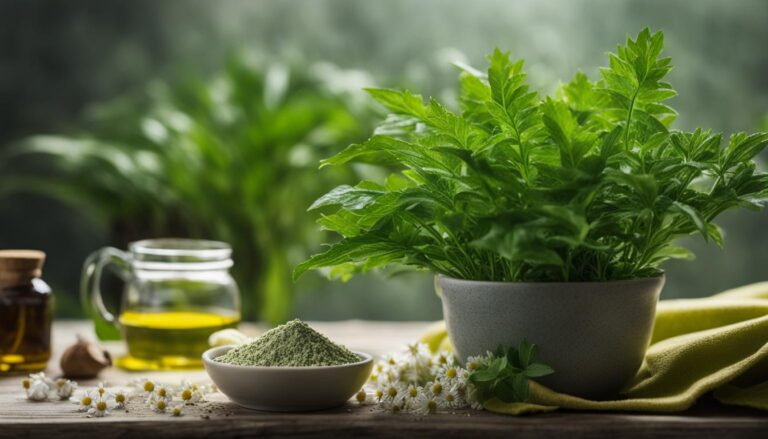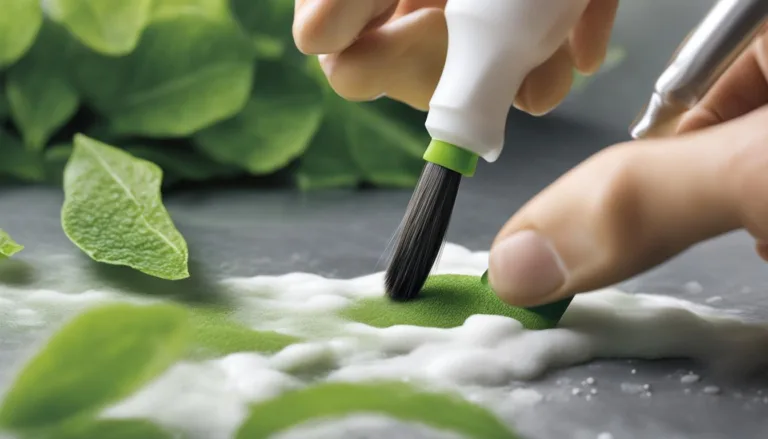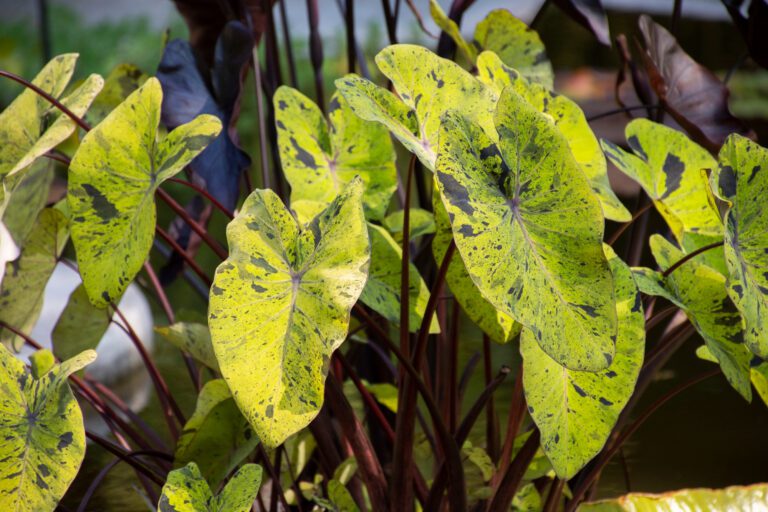
Are you worried about the yellow leaves on your plants? Don’t fret! In this guide, I will share effective remedies and tips to help you address and prevent yellow leaves on your indoor and houseplants.
By following these remedies and tips, you can maintain healthy, vibrant foliage and promote overall plant health. Let’s dive in and fix those yellow leaves!
Key Takeaways:
- Yellow leaves can indicate various root causes such as moisture stress, pest infestation, lack of sunlight, exposure to cold drafts, nutrient deficiencies, overfeeding, and disease.
- To address moisture stress, check the plant’s soil moisture and adjust the watering schedule accordingly.
- Inspect your plants for pest infestations such as mealybugs and spider mites, and take appropriate measures to eliminate them.
- Ensure your plants receive adequate sunlight by placing them in a sunny spot or near a window.
- Protect your plants from cold drafts, as they can cause yellowing leaves.
- Ensure proper nutrition by providing your plants with the right nutrients through plant food or fertilizers.
- Avoid cutting off yellow leaves prematurely, as they can serve as temporary life support for the plant.
Step 1: Checking for Moisture Stress
Moisture stress is a common cause of yellowing leaves on plants, and it can be attributed to both underwatering and overwatering. To determine if your plant is experiencing moisture stress, you need to assess the moisture level in the soil. Press your finger about an inch into the soil to check its moisture content.
If the soil feels dry and parched, it indicates that the plant is not receiving enough water and may be experiencing dehydration. In this case, you should adjust your watering schedule and ensure that the plant receives adequate water to prevent further yellowing.
On the other hand, if the soil feels overly damp and waterlogged, this indicates overwatering, which can lead to root rot. To remedy this, you should reduce the frequency of watering and improve the drainage of the plant’s pot or container.
This will allow excess water to flow out and prevent the roots from sitting in water, thus addressing the moisture stress and preventing further damage.
Additional Tips for Moisture Stress:
- Use well-draining soil to ensure proper water absorption and prevent waterlogging.
- Water your plants thoroughly but avoid overwatering or creating standing water in the pot’s saucer.
- Consider the specific water needs of different plant species and adjust your watering routine accordingly.
- Monitor the humidity levels in your plant’s environment and make adjustments if necessary.
By addressing moisture stress and providing your plants with the right amount of water, you can help restore their health and prevent further yellowing of the leaves. It is important to note that moisture stress is just one potential cause of yellow leaves, and it is essential to consider other factors and perform thorough troubleshooting to ensure the overall well-being of your plants.
Step 2: Look for Unwelcome Critters
Another common cause of yellowing leaves on plants is a pest infestation. Mealybugs and spider mites are common pests that can provoke yellowing leaves. These tiny critters can wreak havoc on your plants by sucking the sap from the leaves, causing them to turn yellow and eventually wither.
To address a pest infestation, it’s important to take immediate action. Start by inspecting your plants for signs of infestation, such as tiny holes on the leaves or a fluffy white wax on the plant. If you spot any of these indicators, it’s time to take control.
“Pest infestations can be detrimental to the health and appearance of your plants. It’s crucial to address the issue promptly to prevent further damage.”
Begin by rinsing off the plant with a gentle spray of water to dislodge any pests. Next, prune the affected leaves to remove any heavily infested areas.
It’s also recommended to use store-bought insecticidal spray or neem oil, which are effective in controlling mealybugs and spider mites. Follow the instructions on the product label for best results.
| Pest | Identification | Treatment |
|---|---|---|
| Mealybugs | Small, white, cotton-like pests found on leaves and stems. | Rinse off the plant, prune affected leaves, and apply insecticidal spray or neem oil. |
| Spider Mites | Tiny, red or brown pests often found under leaves, leaving webbing behind. | Rinse off the plant, prune affected leaves, and apply insecticidal spray or neem oil. |

By taking these steps, you can effectively combat pest infestations and prevent further damage to your plants. Regularly inspecting your plants and providing them with the care they need will help keep these unwelcome critters at bay, ensuring vibrant and healthy foliage.
Step 3: Provide Adequate Sunlight
Sunlight plays a crucial role in the healthy growth of plants. Lack of light can contribute to yellowing leaves on plants, as they rely on sunlight for photosynthesis, which is essential for producing energy and nutrients.
If you notice your plants exhibiting yellow leaves, it may be an indication that they are not receiving enough light. In such cases, providing adequate sunlight is an important step in addressing the issue.
One effective remedy is to consider relocating your plants to a spot where they can receive more direct sunlight. Placing them near a window or in a sunny area of your home can help them thrive.
It is important to be cautious when relocating plants, as sudden changes in light exposure can be stressful for some varieties. Gradually introduce them to increased sunlight to allow them to adjust and avoid shock.
Effects of Window Exposure
Window exposure can be a double-edged sword when it comes to plant health. While it allows sunlight to reach your plants, it can also expose them to temperature fluctuations and cold drafts, which can cause stress and lead to yellowing leaves. To prevent this, avoid placing plants too close to drafty windows or areas with excessive temperature variations.
Remember, each plant has specific light requirements, so it’s essential to research the lighting needs of your specific plant species. Providing the right amount of sunlight can help prevent yellowing leaves and promote overall plant health.
| Plant | Light Requirements |
|---|---|
| Snake Plant (Sansevieria) | Tolerates low-light conditions |
| Fiddle Leaf Fig (Ficus lyrata) | Requires bright, indirect light |
| Pothos (Epipremnum aureum) | Thrives in low to moderate light |
| Rubber Plant (Ficus elastica) | Prefers bright, indirect light |
| Spider Plant (Chlorophytum comosum) | Thrives in bright, indirect light |
Step 4: Protect from Cold Drafts
When it comes to keeping your plants healthy and vibrant, it’s important to protect them from cold drafts. This is especially crucial for tropical and temperature-sensitive plants that thrive in warmer environments.
Exposing these plants to drafty windows or overactive air conditioning can lead to yellowing leaves and overall decline in plant health.
To prevent this, it’s recommended to find a warmer, less drafty location for your plants. Consider moving them away from drafty windows and ensuring they are not too close to air conditioning vents.
Creating a stable and consistent temperature environment will help prevent leaf discoloration and keep your plants happy.
It’s also worth noting that sudden changes in temperature can shock plants and cause leaf damage. Gradually acclimating your plants to new environments can help them adjust more easily and minimize stress.
So, take the time to carefully choose the best spot for your temperature-sensitive plants, and provide them with the warmth and comfort they need to thrive.
Tips for protecting plants from cold drafts:
- Avoid placing plants near drafty windows or doors
- Ensure proper insulation of windows and doors to minimize cold air seepage
- Move temperature-sensitive plants away from air conditioning vents
- Create a barrier using curtains or blinds to block cold drafts
- Consider using space heaters or heat mats to provide additional warmth
Step 5: Ensure Proper Nutrition
Nutrient deficiencies can result in leaf discoloration and yellowing leaves on plants. If you notice that the older leaves of your plant are turning yellow while the new leaves remain light green, it may be a sign of a nitrogen deficiency. Nitrogen is an essential nutrient for plant growth and plays a vital role in maintaining healthy leaf color.
To address nutrient deficiencies and promote healthy foliage, it is important to provide your plants with the right nutrients. This can be done through plant food or fertilization.
Choose a fertilizer that is specifically formulated for your type of plant and follow the recommended application instructions. Applying too much fertilizer can also cause leaf discoloration, so be sure to follow the guidelines.
When fertilizing your plants, it is important to ensure that the nutrients are evenly distributed throughout the soil. This can be achieved by gently working the fertilizer into the top layer of soil or by using a slow-release fertilizer that gradually releases nutrients over time.
Regularly monitoring the nutrient levels of your plants and adjusting your fertilization routine as needed will help prevent nutrient deficiencies and promote vibrant, healthy leaves.
| Nutrient | Function | Signs of Deficiency | Food Sources |
|---|---|---|---|
| Nitrogen | Promotes leaf and stem growth | Yellowing leaves, stunted growth | Fish emulsion, blood meal, compost |
| Phosphorus | Supports root development and flower production | Purple leaves, weak stems | Bone meal, rock phosphate, worm castings |
| Potassium | Aids in overall plant health and disease resistance | Yellowing or browning leaf edges | Wood ash, kelp meal, compost |
Remember to always follow the specific needs of your plants and adjust your fertilization routine accordingly. Providing proper nutrition will not only prevent yellowing leaves but also contribute to the overall health and vitality of your plants.

Why Not to Cut off Yellow Leaves
When faced with yellow leaves on plants, many people’s first instinct is to immediately remove them. This may not always be the best approach.
Yellow leaves often serve as temporary life support for the plant, providing vital nutrients and energy that can aid in its recovery. By cutting off these leaves prematurely, we may be depriving the plant of the resources it needs to bounce back.
Yellow leaves are generally a sign that something is amiss in the plant’s environment, such as moisture stress, pest infestation, or nutrient deficiencies.
It’s important to address the underlying issue causing the yellowing leaves rather than simply removing them. By doing so, we can improve the overall health of the plant and prevent future leaf discoloration.
Furthermore, cutting off yellow leaves can put additional stress on the plant. Plants have a limited capacity to recover from damage, and removing leaves unnecessarily can hinder their ability to bounce back. Instead of focusing on removing the symptoms, we should prioritize identifying and resolving the root cause of the problem.
In conclusion, cutting off yellow leaves may seem like a quick fix, but it can do more harm than good in the long run. By leaving the leaves intact and addressing the underlying issues, we can support the plant’s natural healing process and promote its overall health.
The Importance of Yellow Leaves
Yellow leaves on plants should be seen as an opportunity to investigate and understand what the plant needs. Each leaf provides valuable information about the plant’s health, and removing them prematurely can hinder our ability to diagnose and address the underlying issues.
By leaving yellow leaves intact, we allow the plant to utilize the stored nutrients in these leaves, aiding in its recovery and ensuring long-term vitality.
“Cutting off yellow leaves prematurely can deprive the plant of essential nutrients and hinder its ability to recover.”
Remember, plants are resilient organisms that have evolved to adapt to their environment. By providing the necessary care and addressing the root causes of yellowing leaves, we can help our plants thrive and maintain their vibrant green color. Embrace the yellow leaves as a sign that your plant is communicating with you and take action accordingly.
Prevention and Maintenance Tips
Proper plant care is essential for preventing yellowing leaves and maintaining overall plant health. By following these prevention tips, you can ensure that your plants thrive and stay vibrant:
- Regular watering: Consistently water your plants to provide them with the moisture they need. Avoid overwatering, as it can lead to root rot, and underwatering, which can cause stress and yellowing leaves.
- Pest control: Keep an eye out for pests that can damage your plants and lead to yellowing leaves. Use organic or chemical insecticides, depending on your preference and the severity of the infestation.
- Proper lighting: Ensure that your plants are getting the right amount of sunlight. Different plants have different light requirements, so place them in areas where they can receive adequate light. Consider using artificial grow lights for indoor plants.
- Nutrient supplementation: Provide your plants with the necessary nutrients by using fertilizers or plant food. This will help prevent nutrient deficiencies that can cause yellowing leaves.
Remember to regularly inspect your plants for any signs of distress, such as yellowing leaves, and take prompt action to address the underlying issues. By implementing these prevention tips, you can create a healthy environment for your plants and enjoy their lush, green foliage.
| Prevention Tips | Benefits |
|---|---|
| Regular watering | Prevents both underwatering and overwatering, maintaining optimal moisture levels for plant health. |
| Pest control | Keeps harmful pests at bay, preventing yellowing leaves and preserving overall plant vitality. |
| Proper lighting | Ensures adequate sunlight exposure, providing plants with energy for photosynthesis and vibrant foliage. |
| Nutrient supplementation | Supplies essential nutrients for healthy growth, preventing nutrient deficiencies and yellowing leaves. |
Remember that each plant is unique, so it’s essential to understand its specific care requirements. By practicing proper plant care and following these prevention tips, you can enjoy the beauty and vitality of your plants for years to come.

Addressing yellow leaves on plants is essential for maintaining their overall health and vitality. By understanding the various remedies and implementing effective solutions, you can troubleshoot the underlying issues and support your plants’ well-being.
Remember, each yellowing leaf is a valuable clue indicating a problem that needs to be resolved. Take the time to diagnose the root cause, whether it’s moisture stress, pest infestation, lack of sunlight, exposure to cold drafts, or nutrient deficiencies. Once identified, you can take appropriate action to rectify the situation.
By following proper plant care practices such as regular watering, pest control, providing adequate sunlight, and nutrient supplementation, you can prevent yellow leaves from appearing in the first place. Maintaining a healthy environment for your plants will promote vibrant green foliage and ensure their long-term prosperity.
After reading this, check out our other articles on:
- Identify Plant Diseases: Guide to Protect Your Greenery
- Effective Guide on How to Fix Root Rot in Houseplants Easily
FAQ
What are the common causes of yellow leaves on plants?
Yellow leaves on plants can be caused by various factors such as moisture stress, pest infestation, lack of sunlight, exposure to cold drafts, nutrient deficiencies, overfeeding, and disease.
How do I check for moisture stress in plants?
To check for moisture stress, press a finger about an inch into the plant’s soil. If the soil is parched, the plant may need more regular watering. If the soil feels damp, overwatering may be the issue.
What should I do if my plant has a pest infestation?
If your plant has a pest infestation, rinse off the plant, prune affected leaves, and use store-bought insecticidal spray or neem oil to address the issue.
Can lack of sunlight cause yellow leaves?
Yes, insufficient sunlight can lead to yellowing leaves on plants. Consider relocating the plant to a sunny spot or near a window to provide adequate sunlight.
How do cold drafts affect plant leaves?
Cold drafts can cause yellowing leaves, especially for temperature-sensitive plants. It is important to find a warmer, less drafty location for these plants to prevent leaf discoloration.
What should I do if my plant has nutrient deficiencies?
If your plant has nutrient deficiencies, provide the plant with the right nutrients, such as nitrogen, through plant food or fertilizers to promote healthy leaf color.
Is it advisable to cut off yellow leaves from plants?
It is not advisable to cut off yellow leaves prematurely as they serve as temporary life support for the plant. Cutting them off can deprive the plant of essential nutrients. Instead, focus on identifying and addressing the underlying issue causing the yellowing leaves.
How can I prevent yellowing leaves on plants?
To prevent yellowing leaves on plants, follow proper plant care practices including regular watering, ensuring proper drainage, protecting plants from pests, providing adequate sunlight, and fertilizing as needed.
How can I address yellow leaves on plants?
By following the remedies and tips outlined in this guide, you can address the underlying issues causing yellowing leaves and promote healthy foliage.






2 Comments
Comments are closed.